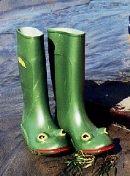The Newbery Medal this year (2008 award) has been given to Neil Gaiman's THE GRAVEYARD BOOK. I'm thrilled to death, because it was such a phenomenal book (my post about it is below, somewhere). I'm also excited because I read and loved this book BEFORE it won the Newbery. I'm pleased and a little surprised that the committee selected this book; it's got some edge to it (the first chapter is a quite horrifying opening sequence about the murder of Bod's entire family, including his child-sister). The Newbery awards its prizes to a variety of kinds of books - not just happy fluff books, or gritty realism that teaches important messages - but The Graveyard Book is uncategorizable, to me - it's a Gaiman fantasy. I do think I need to think more about how to classify the book - as an intellectual exercise, not so much because I believe that books need classification. At any rate, Newbery medal winner The Graveyard Book is an astonishingly wonderful book, and I couldn't be happier about the win.
Now for Coraline.
For a couple of years, I've had a copy of Coraline on my bookshelf; I picked it up for 49 cents at a goodwill store. Then, for some reason, I resisted reading it. I have no idea why. But this Friday, coinciding with the release of Henry Selick's Coraline film, I read it.
And loved it. What a deliciously creepy, inventive book! I wonder about the eye motifs - why buttons? why eyes? why dolls? It makes me think of Hoffman's creepy "Sandman" story; perhaps it's meant to.
I thought the book was fantastic. I loved Coraline, the explorer-heroine. I loved her impulse to explore - it's one that I can connect with, both in recalling my child-self and in my adult-self now (and to be honest, I am not at all sure there's much difference between the child-self and the adult-self, in terms of imagination). I liked her bored snarkiness with her neighbors and family; not malicious, not bratty, simply - apart from the realm of what adults find interesting, or what adults think kids find interesting. Possibly my favorite line comes early on, when Coraline reflects on the dull or dumb things adults say: "She wondered who they thought they were talking to."
This sums up, brilliantly and concisely, Coraline's personality and also my own thinking about adult-child relationships here in my own "real" world. I often wonder, seeing adults clucking and cooing at small children, who they think they are talking to. Likewise with older children, who are people deserving of respect and honest attention.
Saturday night I saw the movie adaptation, which was staggering. Selick's stop-motion animation is just unbelievably well suited to the story, and he handles it marvellously. My only complaint, really, is the insertion of Wybie, the male foil to Coraline - he's not in the book, and he isn't necessary at all. Coraline can manage on her own just fine. I suspect Wybie of being an invention designed to bring in boy viewers, which - if true - infuriates me. Girls and woman have, for years, been expected (and been able) to identify with male protagonists, and male protagonists only, in texts where there's a real absence of meaningful female characters. So why can't boys and men learn to do the same?
The other-world Selick devises is obviously his raison d'etre for making the film. the lavish attention, the long sequences, on the delights and wonders contrived for Coraline in the other-world are the most gorgeous, dreamy moments of the entire film. The garden made for Coraline by the other-father is beautiful and amazing and magical, even before the camera pulls back and reveals that the entire garden has been grown in the image of Coraline's face. That detail only makes it more beautiful.
The mouse circus sequence was my other favorite, aesthetically (Spink and Forcible's burlesque act is HYSTERICALLY funny, a genius moment of "adult" entertainment that had the entire theatre giggling). Pink cotton candy is, to me, one of the most visually pleasing things in the world, and the cannons shooting out cotton-candy cones were a lovely trick.
The joy and beauty in the film - visually - is in the exquisite craftsmanship of the sets and characters. the entire thing - every piece - is handmade, and it gives the film an extra layer of magic, somehow. The textures of Coraline's sweater, her rainboots and slicker, the fluff of the cotton candy, the shine of the black button eyes - are all wonderfully vivid and real. It's a movie that makes me wish for a fabulous dollhouse, with a doll-garden, and finely detailed doll accessories.
Selick's adaptation necessarily contains changes; Wybie is really the only egregious one, the one I have real issue with. The voice of the black cat did not match MY sense of the cat's voice from the book, but it worked nonetheless. But aesthetically, Selick's film is a perfect match with Coraline the book. I was not lucky enough to see it in 3D (I would like to, if I can find a 3D theatre in town), but even barring that, Coraline was an extraordinary visual experience.
Subscribe to:
Post Comments (Atom)




1 comment:
Ah, it's always refreshing to hear from the ocean territory. Love your post and can't wait to see the emovie and to read The Graveyard Book. Yes, isn't it good that the Newbery folks are varied and surprising and flexible!
Post a Comment